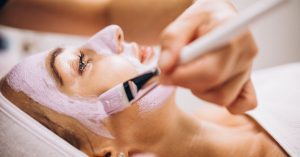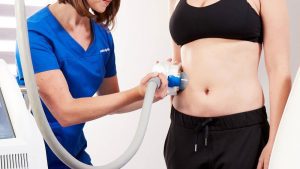What is Laser Liposuction? as we explain it before in another post, Laser liposuction or lipolaser, as its name indicates, is a technique that attacks the body fat by means of high-intensity laser light, dissolving the adipose cells to allow its extraction without damaging the rest of the tissues. The key to this technique is that it removes fat and tightens the skin by stimulating collagen production. Which achieves the desired aesthetic effect and promotes immediate recovery without bruising or bleeding.
It is very effective in larger areas (abdomen, flanks or legs) as well as in small rebel areas (double chin, chest, lower abdomen). And also in areas where the skin tissue is more sensitive and tends to sag, such as the inner side of the arms. In general terms, this technique reduces the risks of traditional liposuction, offers better results, and helps combat cellulite.
How does Liposuction Laser works?
The non-invasive Laser Liposuction can stimulate the adipose cell or adipocyte to release much of its cellular content (water, fatty acids, and glycerol) into the interstitial space. Subsequently, it is drained and metabolized naturally by the body. Thus the fat cell significantly reduces its size, which translates into a loss of centimeters for patients.
The basic treatment with the Non-invasive Laser Liposuction is composed of a frequency of use of 2 to 3 times per week for a minimum of 3 weeks. The treatment can continue for as many weeks as the treatment requires.
Most importantly, the sessions have a duration of 15 minutes per area. So depending on the areas treated, the total time of the session will be between 15 to 60 minutes approximately.


Traditional liposuction vs laser liposuction
Thanks to technological advances, it is possible to access new treatments that make our lives easier. Laser liposuction is a new item on the market. There are differences between this new way of removing fat and what we know as traditional liposuction. One of the main characteristics that must be taken into account is that laser liposuction is a body contouring that eliminates fat attached to the body. The differences between these two procedures are in the recovery and the results.
Traditional liposuction requires general anesthesia. The consequences of this are inflammation, a longer postoperative period, and delayed recovery. If you want to know more about the risks of using anesthesia, go here. On the other hand, laser liposuction only requires local anesthesia or simple sedation, which will allow a faster recovery.
The intervention is different in both cases. In traditional liposuction, a cannula and an aspirator are usually inserted, which allows the fatty tissue to be removed after infiltration. The lipolaser consists of introducing a laser fiber through a very thin cannula, through a small incision that accesses the subcutaneous fat in such a way that it manages to liquefy it without the need to aspirate it, producing a natural elimination of the fat. A fundamental aspect of laser liposuction is that the heat produced by the laser causes a retraction of the collagen in the dermis (skin layer), generating a lifting effect that does not cause asymmetries that can appear in traditional liposuction..
On several occasions, thanks to the procedure that is carried out with a traditional lipo, it cannot be carried out in some parts of the body. On the other hand, thanks to laser liposuction, fat can be extracted from places such as the buttocks, back, and knees.We know that there are many processes to eliminate fat. If you want to know another one of them, we invite you to learn about liposculpture.
Is Laser Liposuction a safe procedure?
As this is a non-surgical procedure, it is pretty safe, does not require anesthesia and recovery time is short. This is why it is considered a safe treatment. However, if you need more information, visit our post: Is laser liposuction a safe procedure?
Also you can communicate with our personnel to ask for this service and request a date on which all your questions will be answered. Just click on Laser Liposuction in Chicago.

Results
The treatment yields result from the first session, but its efficiency lies in the system of continuous use (2 or 3 times a week for at least 3 weeks), since the results are progressive and cumulative.
The average loss in centimeters in the abdominal area per session can be between 0.5 cm and 1.5 cm, with an efficacy of 97.4% according to clinical studies revealed by the ASLMS.
If you are interested in the results, you can read a testimony of one of our clients here: Laser Liposuction Before and After.
If you are interested in Laser Fat Removal in Chicago Il call our Spa in Chicago. Our professionals will be happy to get your call.
Attention and recommendations
Several aspects must be taken into account, and some recommendations to have a faster recovery. The body undergoing this type of procedure undergoes a number of changes. It is important to take care of yourself so as not to have problems. A fundamental aspect is to enter a stage of detoxification through a diet proposed for each patient. This period is crucial to improving the metabolism of the body. It is important to know that this care must be given prior to laser intervention.
After the procedure, postoperative care should be done with some massage sessions, lymphatic drainage, and, above all, the use of girdles. This is done in order to favor the retraction of the skin and avoid the formation of scars. As in the case of the appearance of fibrosis.

The first 48 hours after the procedure are considered the most difficult, as this is where the most care should be taken. However, these types of procedures do not require hospitalization. Moderate care is required. It is essential to maintain moderate physical activity, such as walking, in order to promote lymphatic and venous circulation. Physical activity should be resumed gradually.

Finally, we will mention some recommendations for activities that are best avoided after this type of procedure: taking baths with very hot water, entering saunas, or turkish baths. Perform exercises in gyms. Deep tissue massage. If you want to have more specific information about medicines and foods, visit this page.




